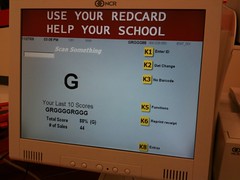Going out and checking in
I’ve been using Foursquare quite a bit lately (here’s my profile). There’s a lot to be impressed by: not least the level of mobile integration. Foursquare doesn’t make much sense if you’re sitting at your desk, so it’s far easier to see where your friends are and check into a new location from the mobile app.
The way it promotes participation is even more interesting. The designers decided that just seeing where your friends were, and getting personalized travel tips, weren’t enough. You gain points – the same kind you get in Sonic the Hedgehog, say – for checking in at a location, exploring new places and telling the app about venues it’s never seen before. In turn, the points lead to badges, and there’s a weekly leaderboard for the top scorers among your friends. There’s no real tangible value to any of this, but you feel good about joining in. As a result, Foursquare is hugely addictive.
Open source participation
Over on Twitter, I asked:
Could the game dynamics used by apps like Foursquare be harnessed to make a more participative open source community?
Open source projects depend on contributions from their communities. Getting people to participate can be difficult; although many people will join in because it scratches some kind of itch, moral incentives like a place in the credits help. However, adding these kinds of game dynamics over the top could provide an extra push. Currently, the only quantifiable open source contributions are source code patches, and any software project has a lot more going on; this would provide an opportunity to quantify other, equally useful forms of participation.
Game dynamics in the enterprise
Graeme Hunter pointed out to me that this model wouldn’t solely be useful for open source. An internal project communications framework that also incorporated game dynamics could be a very interesting platform for ideas, solutions and internal innovation. He’s right; I think it’s an idea to keep in mind if you’re looking for software to use internally for your project.
There are also implications for online communities, where game dynamics are often already used (to rate individual contributions, for example). What if we used similar ideas for education? Or a community centering around journalism?
Photo by dpstyles, released under a Creative Commons license. It’s of a Target store in Milford, Massachusetts, where they use game dynamics to encourage faster checkout times.
Update: Graeme comments below with an exploration of what a participation framework using game dynamics might involve.

Leave a Reply